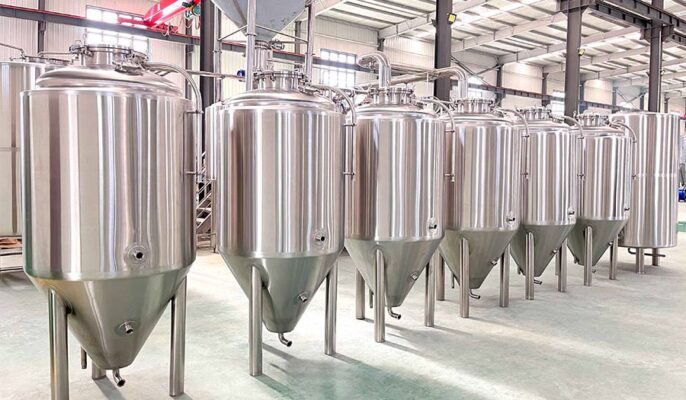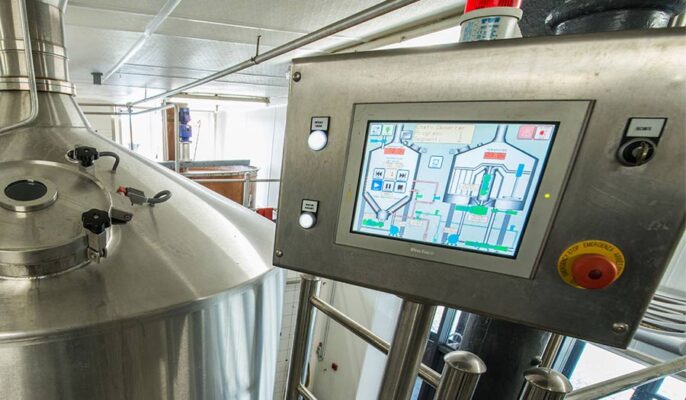Temperatuurregeling is een fundamenteel aspect van het brouwproces dat een vitale rol speelt bij het garanderen van de kwaliteit en consistentie van het eindproduct. Van het maischen tot het gisten en conditioneren, het regelen van de temperatuur in elke fase van het brouwproces heeft een directe invloed op de smaak, het aroma en de algemene kenmerken van het bier of de andere gebrouwen drank. Stabiele temperaturen zorgen voor consistentie in het brouwproces, verminderen de variaties tussen batches en zorgen ervoor dat elk bierflesje de verwachte smaak en kwaliteit heeft.
Waarom de fermentatietemperatuur regelen?
Het regelen van de gistingstemperatuur is waarschijnlijk de grootste stap om de meeste vooruitgang te boeken bij het brouwen van bier. Eenvoudig gezegd presteert typische brouwersgist het best tussen 66 en 72 °F. Dit is de optimale temperatuur om ervoor te zorgen dat de gist zijn werk doet zonder al te veel ongewenste bijsmaken te produceren. Gist gedijt goed bij warmere temperaturen, maar ze vermenigvuldigen zich sneller en produceren daarbij meer esters.
Bijsmaken worden vaak geassocieerd met ongecontroleerde fermentatietemperaturen:
- Foezelalcoholen: worden vaak gezien als een warme alcoholsmaak die bijna smaakt naar wijn of wodka, maar deze smaak verdwijnt meestal tijdens het conditioneringsproces.
- Esters: Worden vaak gezien als fruitige, banaan-, peer- of nagellakverwijderaarsmaak. Hoewel sommige esters welkom zijn in bepaalde stijlen, zoals witbier, raken ze je vaak wanneer je dat niet zou moeten doen. Esters zullen afnemen tijdens het conditioneren, maar een overdosis zal na verloop van tijd nooit verbeteren.
- Acetaldehyde: Wordt vaak waargenomen als groene appel, rauwe pompoen of courgette. Acetaldehyde is een natuurlijk bijproduct van elke fermentatie, maar in ongecontroleerde omstandigheden kan het in overmaat aanwezig zijn.

Hoe wordt wort gekoeld?
De meeste brouwerijen koelen wort via enkel- of tweetraps platenwarmtewisselaars. Deze toepassing is veeleisend; er moet een grote hoeveelheid warmte uit het proces worden verwijderd. Een glycol-watermengsel in de waterlus versterkt het koelingseffect. Er wordt vaak gekozen voor dubbelwandige voedselveilige warmtewisselaars om vervuiling tussen het wort en de koelvloeistof te voorkomen.
Factoren om te overwegen:
- Totale hoeveelheid wort die gekoeld moet worden (meestal uitgedrukt in BBL/vatvolume).
- Benodigde uitkloptijd (afkoeltijd die nodig is om het proces te optimaliseren).
- Initiële worttemperatuur en gewenste eindtemperatuur van het wort.
- Kan de koelmachine ook koelcapaciteit leveren voor andere brouwprocessen?
De rol van temperatuurregeling in het brouwproces
Stampen
Tijdens het maischen worden gemalen granen gemengd met heet water om vergistbare suikers te extraheren en een suikerhoudende vloeistof te produceren die wort wordt genoemd. De temperatuur tijdens het maischen beïnvloedt het type en de hoeveelheid geëxtraheerde suikers. Lagere temperaturen bevorderen de productie van meer vergistbare suikers, wat resulteert in een droger, meer verdund bier. Hogere temperaturen bevorderen de productie van minder vergistbare suikers, wat resulteert in een zoeter, vol bier. Nauwkeurige temperatuurregeling is essentieel voor het maischen om de gewenste wortsamenstelling te bereiken en een goede basis te leggen voor de rest van het brouwproces.
Kokend
Na het maischen wordt het wort gekookt om het te steriliseren en wordt hop toegevoegd om bitterheid, smaak en aroma toe te voegen. De duur en intensiteit van het kookproces beïnvloeden de uiteindelijke bitterheid en het karakter van het bier. Temperatuurregeling tijdens het kookproces helpt overmatige karamelisatie voorkomen en zorgt voor een consistent bitterheidsprofiel.
Gisting
Fermentatie is een belangrijke fase waarin gist de suikers in het wort verbruikt en alcohol en kooldioxide produceert. De gistingstemperatuur beïnvloedt het gedrag van de gist aanzienlijk, wat resulteert in de productie van verschillende esters en andere smaakverbindingen. Temperatuurregeling is hier cruciaal, aangezien verschillende giststammen specifieke temperatuurbereiken hebben waarbinnen ze het beste presteren. Te hoge of te lage temperaturen kunnen leiden tot bijsmaken, vastzittende gisting of overmatige activiteit van de gist, wat allemaal een negatieve invloed kan hebben op de smaak en het aroma van het bier.
Conditionering
Na de gisting moet het bier geconditioneerd worden om de smaak te laten rijpen en verder te ontwikkelen. Tijdens het conditioneringsproces is temperatuurregeling essentieel om de gewenste chemische reacties te vergemakkelijken, waaronder de afbraak van ongewenste verbindingen en de vorming van gewenste smaakverbindingen. Een goede temperatuurregeling zorgt ervoor dat het bier het gewenste smaakprofiel en de gewenste helderheid krijgt.

Waarom is temperatuurregeling belangrijk in het fermentatiebrouwproces?
Temperatuurregeling tijdens fermentatie
Bier vergisten op de juiste temperatuur helpt gist om suikers om te zetten in alcohol, wat resulteert in een heerlijk bier met een sterke smaak. Als de temperatuur te hoog of te laag is, kan de giststam traag worden of helemaal afsterven en dus niet goed werken.
Lage temperaturen kunnen er ook voor zorgen dat de zuurtegraad van het bier toeneemt, terwijl hoge temperaturen ervoor kunnen zorgen dat er bij het bier bijsmaken ontstaan zoals esters en foezelolie. Daarom is het heel belangrijk om goed te letten op de gistingstemperatuur van het wort tijdens het brouwproces.
Vorming van biersmaak en -aroma
De gistingstemperatuur heeft een aanzienlijk effect op de smaak en het aroma van bier. Bij verschillende temperaturen zijn de resulterende smaakcomponenten van bier verschillend. Bij de juiste temperatuur kan gist suikers snel en volledig omzetten in alcohol en kooldioxide, waardoor de vergistingsefficiëntie en het rendement toenemen. Als de temperatuur te hoog is, kan de gist zijn activiteit verliezen door oververhitting; als de temperatuur te laag is, zal de fermentatiesnelheid vertragen en kan dit zelfs leiden tot een onvolledige fermentatie. Bij het brouwen van bier is temperatuurregeling cruciaal voor de vorming van smaak en aroma. De temperatuur heeft niet alleen invloed op de activiteit van het bier, maar is ook direct gerelateerd aan de verschillende smaakcomponenten die tijdens het gistingsproces worden geproduceerd.
Efficiënter brouwen
Door de gistingstemperatuur nauwkeurig te regelen, kan de stabiliteit en voorspelbaarheid van het brouwproces worden gegarandeerd, waardoor de productie-efficiëntie verbetert en de productiekosten dalen. Tegelijkertijd kunnen wijnen van hoge kwaliteit ook een hogere marktwaarde en economische voordelen opleveren.
Hoe bereik je een nauwkeurige temperatuurregeling?
- Warmtewisselaars: Warmtewisselaars worden gebruikt om het wort snel af te koelen na het koken, om enzymatische reacties te stoppen en het risico op bijsmaken te verminderen. Tegenstroomwarmtewisselaars of platenwarmtewisselaars komen vaak voor in brouwerijen en ze brengen warmte over van heet wort naar koud water terwijl ze de twee gescheiden houden.
- Temperatuurregelaars: Temperatuurregelaars zijn apparaten die fermentatietanks regelen en de temperatuur van vaten regelen. Ze houden de temperatuur binnen een bepaald bereik, waardoor brouwers het gistingsproces kunnen aanpassen aan het optimale temperatuurbereik van gist. Temperatuurregelaars bieden precisie en stabiliteit, wat het risico op bijsmaken of giststagnatie kan verminderen.
Tips voor temperatuurregeling
De gistingstemperatuur verhogen
- Wikkel de fermentor in iets als een slaapzak of geïsoleerde deken. Door de fermentor in te pakken, sluit je de warmte van de gistgisting in, waardoor de temperatuur stijgt.
- Plaats de fermentor in een kartonnen doos of geïsoleerde ruimte voor een vergelijkbaar effect.
- Een andere manier om de temperatuur te regelen is om de fermentor onder te dompelen in een emmer water en een aquariumverwarming te gebruiken om de temperatuur op peil te houden.
Fermentatietemperatuur verlagen
- De eenvoudigste methode is om de fermentor in een vochtige handdoek te wikkelen. Terwijl het water verdampt, koelt de buitenkant van de fermentor af.
- If this doesn’t work, you can place the fermenter in about 1-2 inches of water and wrap the fermenter in a damp towel, making sure the towel is touching the water. This provides a constant supply of moisture for evaporation.
- Je kunt ook ijsblokjes aan het water toevoegen of een ventilator aanzetten om het water verder af te koelen. Je kunt de karaf ook onderdompelen in een emmer water en een ijspack gebruiken om de temperatuur te verlagen. Je moet het ijspak regelmatig vervangen om de temperatuur constant te houden.

FAQ
Waarom moet de temperatuur gecontroleerd worden tijdens het fermentatieproces?
Tijdens het fermentatieproces is de temperatuur een belangrijke factor die de activiteit van micro-organismen, de stofwisselingssnelheid en de kwaliteit van fermentatieproducten beïnvloedt. Verschillende micro-organismen hebben hun optimale groei- en fermentatietemperatuurbereik. Alleen bij een geschikte temperatuur kunnen micro-organismen zich snel reproduceren en substraten efficiënt omzetten in de gewenste producten.
Hoe bepaal je de optimale temperatuur tijdens het fermentatieproces?
Om de optimale temperatuur tijdens het fermentatieproces te bepalen, moet rekening worden gehouden met veel factoren, waaronder microbiële soorten, substraatkenmerken, fermentatieprocesomstandigheden, enz.
Hoe kun je de fermentatietemperatuur nauwkeurig regelen?
Voor een nauwkeurige regeling van de fermentatietemperatuur zijn geavanceerde temperatuurregelapparatuur en -technologie nodig. Gangbare apparatuur voor temperatuurregeling omvat incubators met constante temperatuur, fermentatietanks, enz. Deze apparaten zijn meestal uitgerust met nauwkeurige temperatuursensoren en regelsystemen die de temperatuur van de fermentatievloeistof in real-time kunnen controleren en aanpassen.




